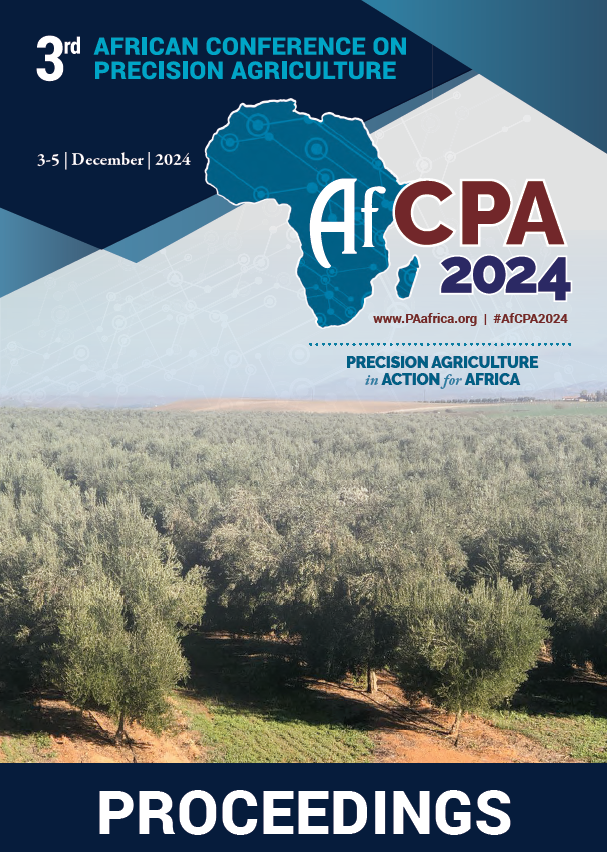Download the Conference Proceedings
Proceedings
Authors
| Filter results7 paper(s) found. |
|---|
1. Estimating greensnap yield damage with canopy reflectance: a case studyGrain yield reduction caused by storm-induced plant breakage (green snap) occurs often in corn fields. With climate change and an increasing frequency in the occurrence of extreme weather events, it is essential to develop methods that can accurately estimate green snap damage, so growers can be properly compensated by insurance companies for yield loss. Because plant breakage also affects crop canopy reflectance, this case study aimed to characterize the changes in crop canopy reflectance... G. Dias paiao, T.J. Nigon, F.G. Fernández, C. Cummings, S.L. Naeve |
2. La fertilité indigène du sol : un élément catalyseur de l’agriculture de précisionDans le contexte actuel de la dégradation des ressources naturelles et des problèmes de disponibilité et d'accessibilité des intrants agricoles, l'agriculture de précision dont le point d'entrée est la connaissance de la fertilité endogène du sol s'impose. Des essais soustractifs ont été conduits pendant deux ans (2018-2019) à la Station d'Expérimentations Agronomiques de l'Université... K. William, J. Sogbedji, M. Lare |
3. The Yield Gap In Africa: Closing the gap through soil attributes management using remote sensing & Precision Agriculture Approaches at the field scaleIn Africa, which has the most population growth in the world, the agricultural system is characterized by the predominance of smallhoder farmers. In order to cope with intense population growth and increased production costs through yield gap closing. Yield gap is defined as the difference between potential yield and actual yield and is an inevitable method to improve yields while decreasing the environmental impacts of agricultural systems. The variability of yields is strongly controlled by... K. Khechba, A. Laamrani, A. Chehbouni, D. Dhiba, K. Misbah |
4. Keynote 8 - Precision Agriculture in Sub- Africa: The Path ForwardSmallholder farmers contribute significantly to food security and rural livelihoods in Africa, but their yields are often low due to declining soil fertility, high input costs, and decreased availability of land for cultivation among other factors. These challenges are exacerbated by climate change. Furthermore, soil physicochemical and biological properties are heterogeneous among farms within same or different agro-ecological zones, with obvious consequences for yields. This variability... K. Frimpong |
5. Self-developed Small Robot for Tomato Plants DetectionA mobile (robot) measuring station for tomato plant detection has been developed, equipped with different sensors and a self-developed hardware and software background. The development aims are the applications in precision crop production: artificial intelligence- based detection, imaging, data collection, automation, and remote sensing. The robot is fault- free in field conditions and is therefore a key development tool for precision farming and digital agriculture. The measurement system developed... B. Ambrus, G. Teschner, M. Neményi, A. Nyéki |
6. Variability in Yield Response of Maize to N, P and K Fertilization Towards Site-specific Nutrient Recommendations in Two Maize Belts in TogoLes régions de savane et du centre sont les principales zones de production de maïs au Togo, mais avec des rendements en grains de maïs à un seuil de seulement 1,5 Mg ha -1 . Nous utilisons une approche participative pour évaluer l'importance des trois principaux macro-éléments (N, P et K) pour la culture du maïs dans les deux régions afin de permettre davantage de recommandations d'engrais spécifiques au site et... J. Sogbedji, M. Lare |
7. Maximisation De L’efficience D’utilisation Des Nutriments : Recommandation De Fertilisation à La Carte Pour Le Maïs Sur Les Ferralsols Du Sud-togoL'amélioration de la nutrition des plantes à travers l'agriculture de précision devient incontournable pour l'optimisation de l'entreprise agricole et la protection de l'environnement. Nous avons conduit pendant la grande saison culturelle de 2019 et 2020, sous culture de maïs (Zea mays L.), des essais soustractifs à base de l'azote (N), du phosphore (P) et du potassium (K) à la station d'expérimentations agronomiques (SEAL)... J. Sogbedji, L. William, M. Lare, A. Sekaya, K. Sika , E. Tagba |
